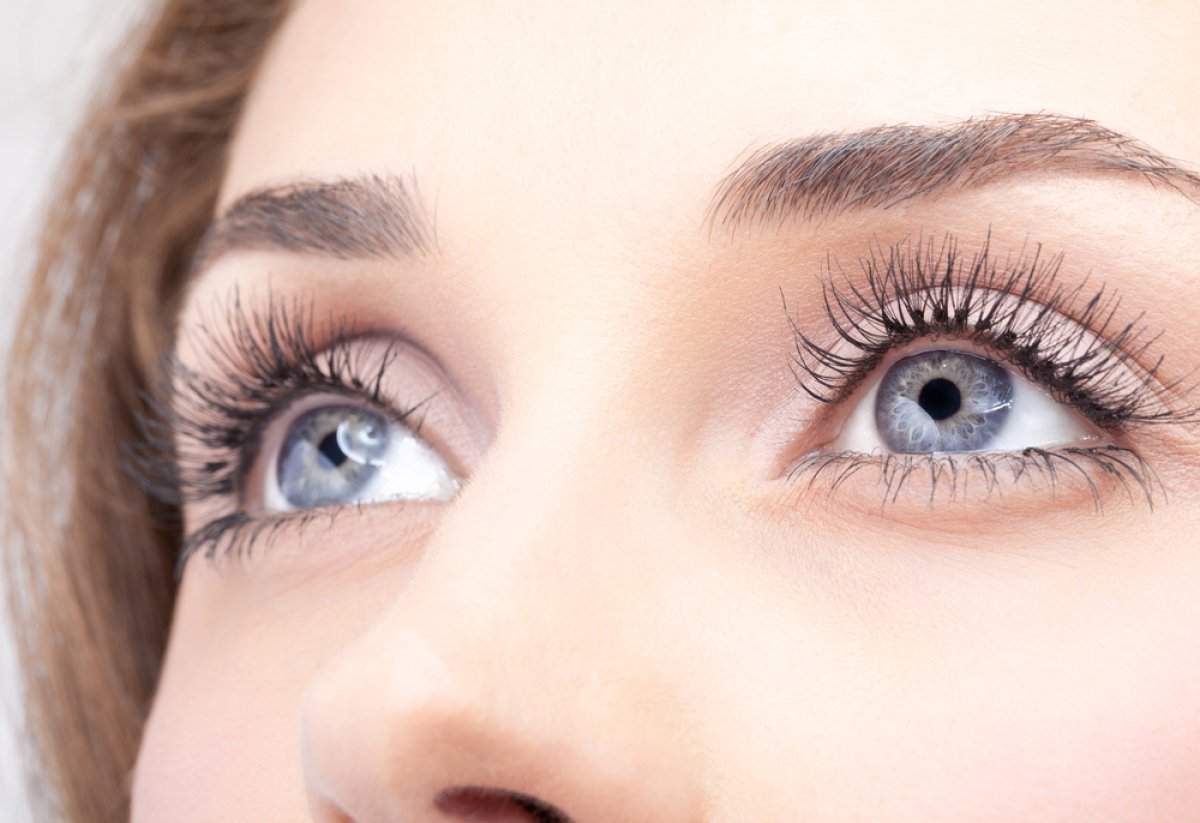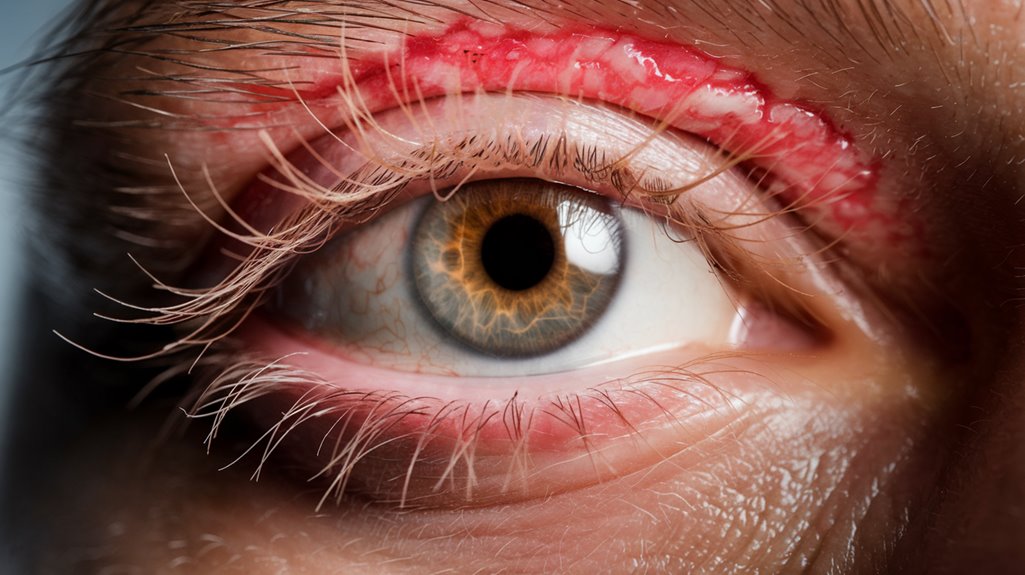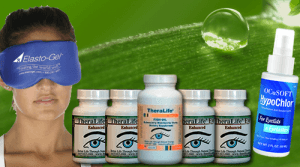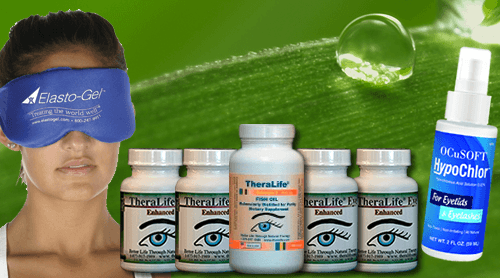Understanding the vicious cycle of blepharitis and dry eye syndrome is crucial for effective management. TheraLife’s products offer significant benefits to customers by addressing the root causes of these conditions. The inflammation and bacterial imbalance on the eyelids that disrupt tear production can be effectively treated with TheraLife’s targeted solutions.
Their products enhance meibomian gland function, which is vital for tear production and eye comfort. TheraLife provides a comprehensive approach, including supplements that incorporate essential omega-3 fatty acids, known for their anti-inflammatory properties. Their formulas are designed to improve eyelid hygiene, reduce inflammation, and promote overall eye health.
Regular use of TheraLife’s products can significantly alleviate symptoms of blepharitis and dry eye syndrome, breaking the cycle of discomfort. In addition to their supplements, TheraLife emphasizes the importance of regular eye check-ups for timely intervention and symptom management. Staying informed and adopting TheraLife’s strategies can greatly enhance the quality of life for those affected by these eye conditions.
Best Blepharitis Treatment From TheraLife
Key Takeaways
- Blepharitis disrupts tear production, worsening dry eye syndrome through inflammation and bacterial imbalances.
- Regular warm compresses enhance meibomian gland function, improving tear quality and reducing inflammation.
- Maintaining eyelid hygiene with cleansers decreases bacterial load and promotes tear film stability.
- Omega-3 fatty acids reduce inflammation and improve tear stability, supporting eye health.
- Consistent eye examinations ensure early detection and management of blepharitis and dry eye syndrome.
Understanding Blepharitis: Causes and Symptoms
While often overlooked, blepharitis is a common condition affecting the eyelids, characterized by inflammation. Understanding its types and risk factors is essential.
Blepharitis can be classified into anterior and posterior types. Anterior blepharitis occurs at the outer edge of the eyelid, often linked to bacterial infections or dandruff-like scalp conditions. In contrast, posterior blepharitis affects the inner eyelid and involves the meibomian glands, frequently associated with skin disorders like rosacea.
Risk factors for developing blepharitis include seborrheic dermatitis, rosacea, and allergic reactions. Additionally, environmental factors such as exposure to dust and smoke increase susceptibility.
Recognizing these elements aids in early diagnosis and management. By identifying blepharitis types and associated risk factors, you can better understand this pervasive eyelid disorder. Eyelid cleansers are essential for managing blepharitis, as they help reduce microbial load and ocular surface inflammation, contributing to effective treatment.
Exploring Dry Eye Syndrome: Triggers and Effects
Blepharitis often coexists with another prevalent ocular condition, dry eye syndrome, which affects tear production and stability.
Recognizing the triggers of dry eye syndrome is essential for effective management. Environmental factors play a significant role: exposure to wind, smoke, or dry air exacerbates symptoms by accelerating tear evaporation.
Additionally, certain lifestyle habits can worsen the condition; prolonged screen time reduces blink rate, leading to inadequate tear distribution.
Dry eyes can result from improper tear function, leading to insufficient production or excessive shedding, as outlined in the knowledge above.
Consider these key triggers:
- Environmental factors: Wind, smoke, dry climate increase tear evaporation.
- Lifestyle habits: Extended screen time reduces blinking, worsening symptoms.
- Contact lens use: Alters tear film composition, causing discomfort.
- Medications: Antihistamines and antidepressants can decrease tear production.
Understanding these factors helps tailor preventive measures, reducing discomfort and improving eye health.
The Connection Between Blepharitis and Dry Eye Syndrome
You’re likely aware that blepharitis, characterized by eyelid inflammation, can greatly disrupt normal tear production, exacerbating dry eye syndrome. This disruption often stems from a bacterial imbalance on the eyelid margin, which affects the quality and quantity of tears produced. Understanding this connection is essential as it underscores the need for targeted treatment strategies to manage both conditions effectively. Inflammatory cytokines, such as IL-1beta and TNF-alpha, play a significant role in the development of dry eye disease, highlighting the importance of addressing inflammation in treatment approaches.
Inflammation and Tear Production
Although inflammation often underlies both conditions, understanding the connection between blepharitis and dry eye syndrome requires a detailed examination of tear production mechanisms.
Inflammation types, including chronic and acute, can directly affect the glands responsible for tear production. When these glands are compromised, it leads to poor tear quality, exacerbating dry eye symptoms. The inflammation in blepharitis causes an imbalance in the tear film, disrupting its composition and stability.
- Inflammation reduces the secretion rate of tears, leading to dryness.
- Compromised tear quality results in inadequate lubrication of the ocular surface.
- Persistent inflammation can cause structural damage to tear-producing glands.
- Chronic blepharitis leads to a continuous cycle of inflammation and tear film instability.
Moreover, meibomian gland dysfunction (MGD) contributes to insufficient oil secretion, further destabilizing the tear film and aggravating dry eye symptoms.
These insights highlight the intricate link between inflammation and impaired tear production.
Bacterial Imbalance Effects
When there’s a bacterial imbalance on the eyelids, it can considerably contribute to both blepharitis and dry eye syndrome. A healthy eyelid microbiome relies on diverse bacterial communities. An imbalance, often characterized by a reduction in microbiome diversity, disrupts this delicate ecosystem. The overgrowth of certain bacteria, such as Staphylococcus species, is a common bacterial imbalance effect that exacerbates inflammation. This inflammation is a primary driver of blepharitis and can impair the meibomian glands. These glands are essential for maintaining tear film stability. Their dysfunction leads to tear film evaporation, a hallmark of dry eye syndrome. Addressing bacterial imbalance effects by restoring microbiome diversity could be a strategic intervention to alleviate symptoms and break the cycle between these ocular conditions. Regular eyelid hygiene is crucial to minimize symptom recurrence and maintain a healthy microbial balance.
How Blepharitis Contributes to Dry Eye Syndrome
Blepharitis, characterized by inflammation of the eyelids, often exacerbates Dry Eye Syndrome by disrupting the normal function of the meibomian glands.
These glands are responsible for secreting oils that form an essential layer of the tear film, preventing evaporation. When blepharitis triggers inflammation, it can block these glands, leading to inadequate oil secretion and increased tear evaporation, heightening dry eye symptoms.
To aid in dry eye prevention, consider the following factors:
- Debris Accumulation: Inflammatory debris can clog meibomian glands.
- Bacterial Growth: Excessive bacteria can worsen gland dysfunction.
- Eyelid Margin Thickening: Swelling restricts proper glandular function.
- Increased Tear Film Instability: Leads to rapid tear evaporation.
Understanding these mechanisms helps you take proactive measures against the cycle linking blepharitis and Dry Eye Syndrome. Good hygiene practices can significantly reduce the occurrence of blepharitis, with recommendations for regular eyelid washing, warm compresses, and avoiding eye makeup during flare-ups to minimize irritation.
The Impact of Dry Eye Syndrome on Blepharitis
Understanding how blepharitis contributes to Dry Eye Syndrome sets the stage for examining how Dry Eye Syndrome reciprocally affects blepharitis.
When your eyes lack adequate lubrication, it exacerbates blepharitis by altering the tear film’s composition. This alteration is a crucial impact factor, as it leads to increased eyelid inflammation and irritation. The compromised tear film fails to provide essential nutrients and protection, intensifying the discomfort associated with blepharitis.
Moreover, dry eyes can hinder the natural flushing of bacteria and debris, further aggravating eyelid margins. Addressing these impact factors is essential for symptom relief. Studies indicate that prolonged screen exposure significantly exacerbates dry eye symptoms, which can further complicate the management of blepharitis.
Recognizing the Symptoms of the Vicious Cycle
As you navigate the complexities of blepharitis and Dry Eye Syndrome, recognizing the symptoms of their vicious cycle becomes essential. Symptom awareness can greatly enhance your ability to manage these conditions effectively. Persistent eye discomfort often signals the onset of this cycle. Keep an eye out for:
- Redness and irritation: Chronic inflammation can exacerbate discomfort, leading to increased redness around the eyelids.
- Itchy and gritty sensation: A hallmark sign, this sensation often signifies the presence of both conditions.
- Crusty eyelids upon waking: This symptom suggests that blepharitis is contributing to an unstable tear film.
- Fluctuating vision: Inconsistent tear production can cause intermittent blurriness, affecting visual clarity.
Understanding these symptoms enables timely intervention, helping to mitigate the cycle’s progression and enhance overall eye health. Regular eye examinations for early detection are crucial in managing these conditions effectively.
Diagnosis and Assessment: Getting to the Root of the Problem
Recognizing symptoms is just the first step; identifying the underlying causes of blepharitis and Dry Eye Syndrome requires an extensive diagnostic approach. A thorough patient history is essential, capturing details about symptom onset, duration, and exacerbating factors. Diagnostic tools like slit-lamp examination and tear film analysis provide critical insights into ocular surface conditions. Tests such as the Schirmer test measure tear production, while meibography visualizes meibomian gland structure. Good eyelid hygiene can help control but not cure blepharitis, emphasizing the importance of regular eye care practices.
| Diagnostic Tool | Purpose |
|---|---|
| Slit-lamp Examination | Evaluates eyelid and tear film health |
| Schirmer Test | Assesses tear production volume |
| Meibography | Visualizes meibomian gland morphology |
| Tear Film Analysis | Analyzes tear composition and stability |
Best Blepharitis Treatment From TheraLife
Add To Cart
Effective Treatment Strategies for Managing Both Conditions
You’ll find that incorporating warm compresses into your routine can greatly enhance meibomian gland function, providing symptomatic relief for both blepharitis and dry eye syndrome. Prioritizing lid hygiene with eyelid cleansers reduces bacterial load and debris, which is essential in managing inflammation. Additionally, supplementing with omega-3 fatty acids has been shown to improve tear stability and overall ocular surface health. The All-in-One Dry Eye Starter Kit offers a comprehensive solution with clinically proven efficacy for these conditions.
Warm Compress Benefits
While managing blepharitis and dry eye syndrome, incorporating warm compresses into your treatment regimen can yield significant benefits.
Utilizing proper warm compress techniques enhances the effectiveness of heat application, providing therapeutic advantages. The gentle heat helps to unclog blocked meibomian glands, thereby restoring the natural oil flow necessary for a stable tear film.
Additionally, heat application benefits include reducing eyelid inflammation and promoting comfort by loosening crusting on the eyelid margins.
Consider these key points:
- Improves oil secretion: Warm compresses stimulate the meibomian glands to secrete oils, enhancing tear quality.
- Reduces inflammation: Regular heat application can decrease eyelid swelling and redness.
- Relieves discomfort: Warmth soothes irritated eyes, alleviating dryness.
- Enhances medication efficacy: Combining warm compresses with prescribed treatments may improve absorption and effectiveness.
Lid Hygiene Importance
Maintaining proper lid hygiene plays a critical role in the effective management of blepharitis and dry eye syndrome. By adhering to rigorous lid care routines, you can mitigate symptoms and disrupt the cycle of inflammation and irritation.
Evidence suggests that consistent hygiene practices, including the gentle cleansing of eyelid margins, help remove debris, bacteria, and excess oils that contribute to meibomian gland dysfunction. Employing sterile wipes or diluted baby shampoo can enhance cleaning efficacy.
Additionally, research highlights that these practices reduce bacterial load and eyelid inflammation, promoting tear film stability. Integrating lid care into your daily routine is essential, as it not only alleviates discomfort but also prevents exacerbation of symptoms, forming the cornerstone of a thorough treatment strategy.
Omega-3 Fatty Acids
Omega-3 fatty acids have emerged as a promising intervention in the management of blepharitis and dry eye syndrome.
These essential nutrients help reduce inflammation, improve tear stability, and support overall eye health. Incorporating omega-3 into your diet can be achieved through various sources and supplements, with specific dosage recommendations tailored to individual needs.
- Omega 3 sources: Include fatty fish like salmon, mackerel, and sardines, as well as flaxseeds and chia seeds.
- Dosage recommendations: Typically, a daily intake of 1,000 to 2,000 mg of EPA and DHA combined is suggested for eye health.
- Clinical evidence: Studies have shown significant improvements in tear production and ocular surface health.
- Consultation: Always discuss with a healthcare provider before starting any supplements to guarantee safety and efficacy.
Lifestyle Changes and Home Remedies for Long-term Relief
For those suffering from blepharitis and dry eye syndrome, integrating specific lifestyle changes and home remedies can offer significant long-term relief.
Implementing lifestyle modifications such as reducing screen time can minimize eye strain, a known exacerbator of symptoms. You might consider using artificial tears regularly as a home treatment to maintain ocular moisture.
Warm compresses, applied daily, can alleviate eyelid inflammation by improving meibomian gland function. Ensuring proper eyelid hygiene with gentle scrubs removes debris and reduces bacterial load.
Additionally, using a humidifier in dry environments helps maintain ambient moisture levels, thereby preventing further drying of the eyes.
These strategies, grounded in evidence-based practice, can effectively interrupt the vicious cycle of blepharitis and dry eye syndrome, promoting sustained ocular health.
Best Blepharitis Treatment From TheraLife
Frequently Asked Questions
How Can Diet Impact Blepharitis and Dry Eye Syndrome?
Your diet directly impacts blepharitis and dry eye syndrome. Consuming anti-inflammatory foods like leafy greens and fatty fish helps reduce inflammation around the eyelids.
Omega-3 benefits are especially remarkable; they enhance tear production and stabilize the tear film. Evidence shows that incorporating omega-3-rich foods, such as salmon and flaxseeds, can greatly alleviate symptoms.
Are There Specific Exercises to Alleviate Symptoms?
You’re wondering if specific exercises can help alleviate symptoms. Consider eye yoga and blinking exercises—while eye yoga promotes flexibility and relaxation, blinking exercises enhance lubrication.
Evidence suggests that regularly practicing these can reduce discomfort. Eye yoga involves gentle eye movements, whereas blinking exercises focus on improving tear film stability.
Both techniques have been shown to greatly improve symptoms when practiced consistently, offering you a proactive approach to managing eye health.
Can Stress Worsen Blepharitis and Dry Eye Syndrome?
Yes, stress can worsen blepharitis and dry eye syndrome.
Your body’s stress response might exacerbate inflammation, leading to more pronounced symptoms. Effective stress management is essential in controlling these conditions.
Engage in regular activities that enhance emotional health, like mindfulness and meditation, to mitigate stress’s impact. Evidence suggests that these practices help reduce systemic inflammation, thereby alleviating ocular discomfort.
Incorporate relaxation techniques into your daily routine to support eye health.
Is There a Genetic Predisposition to These Conditions?
When it rains, it pours, and you might wonder if your blepharitis or dry eye syndrome runs in the family.
Genetic factors do play a role, and research shows a significant link between these conditions and family history.
Studies indicate that if your relatives suffer from these issues, you might be more susceptible too.
Understanding these genetic predispositions helps you manage and potentially mitigate risks more effectively with proper medical guidance.
How Does Screen Time Affect These Eye Conditions?
When you spend significant time in front of screens, screen exposure can exacerbate eye conditions by reducing your blinking frequency.
Normally, you blink about 15 times per minute, but screen exposure may cut this rate by half. This reduced blinking doesn’t allow your eyes to maintain adequate moisture, worsening symptoms of dry eyes.
Studies indicate that increased screen time is linked to greater discomfort and irritation, emphasizing the need for frequent breaks and conscious blinking.
Best Blepharitis Treatment From TheraLife
Conclusion
Theralife.com offers an array of products designed to tackle the interconnected issues of blepharitis and dry eye syndrome. By using Theralife’s natural, evidence-based treatments, customers can break the cycle of eye irritation and discomfort. These products focus on addressing root causes, rather than just symptoms, to provide long-lasting relief.
Theralife’s approach includes dietary recommendations, lifestyle changes, and natural supplements that help enhance eye health. They offer specialized treatments for conditions like uveitis, chalazion, and Sjogren’s syndrome, ensuring a comprehensive eye care solution. Additionally, they provide guidance on the best practices for eye makeup use, especially for those with blepharitis and dry eyes, to further minimize irritation.
Imagine experiencing a life where your eyes feel comfortable and at ease. That’s the potential Theralife products hold for their customers, empowering them with the tools and knowledge to manage their eye health effectively.





